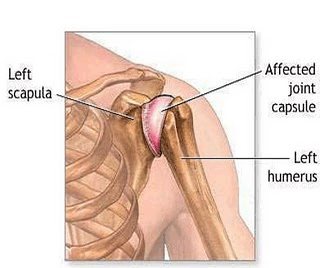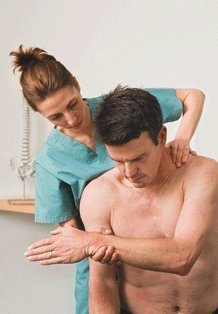What is a Frozen Shoulder?

Common Symptoms of a Frozen Shoulder:
- Limited and restricted movement of the shoulder
- Constant, dull aching shoulder pain that does not subside
- Trouble sleeping on the shoulder due to pain
- Difficulty doing simple tasks such as tying a shoe or brushing your hair
Causes of a Frozen Shoulder
Generally, frozen shoulders occur without an associated injury or cause. It is possible for a patient to develop a frozen shoulder after some sort of injury, but most occurences do not have a specific mechanism of injury.
There are specific risk factors that may make a patient more likely to develop a a frozen shoulder, including:
Endocrine Disorders
Those with diabetes, thyroid dysfunctions, or similar endocrine disorders are at greater risk for developing a frozen shoulder.
Age and Gender
A frozen shoulder most commonly affects people between 40 – 60 years of age. It is twice as common in women than it is in men.
Shoulder Surgery or Trauma
Other shoulder injuries or a shoulder related surgery can lead to frozen shoulders. If prolonged joint immobilization occurs after a surgery or injury, the risk is increased.
Other Conditions
Other conditions such as Parkinson’s or heart disease have been linked to increased risk of a frozen shoulder.
It is not fully understood how or why frozen shoulder occurs. In many cases, the shoulder joint becomes stiff and scarred without any clear method of injury.
Frozen Shoulder Treatments

Physical Therapy
Most therapists will have an exercise and stretching program to follow designed to relieve the pain of the shoulder. These exercises should be done several times a day, even when you are not seeing your physical therapist to ensure a full recovery.
Cortisone Injections
Commonly used to reduce inflammation in the shoulder area. Also provides pain relief, which allows for an easier time performing the stretching and exercises.
Anti-inflammatory Medication
Not required in the healing process, but can help greatly in pain reduction.
Frozen Shoulder Surgery
Surgery for a frozen shoulder is typically unnecessary, as most frozen shoulders can be successfully treated using the aforementioned methods. However, if conservative treatments do not alleviate patients’ symptoms, the surgeon may choose to perform manipulation under anesthesia. During this procedure, the surgeon moves the arm through its range of motion to break adhesions caused by the shoulder. No actual incisions are made, and it is an outpatient operation.






